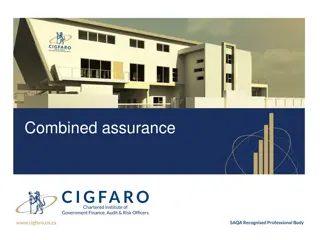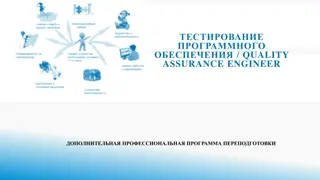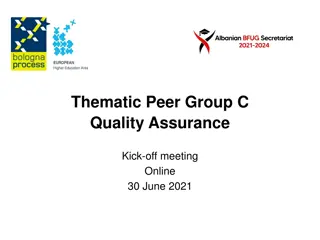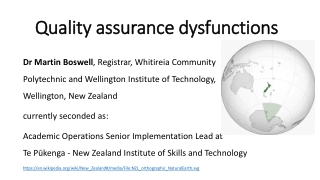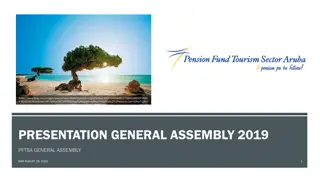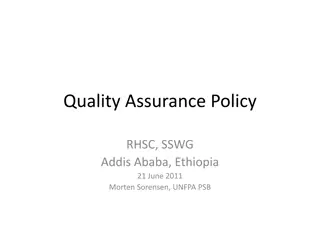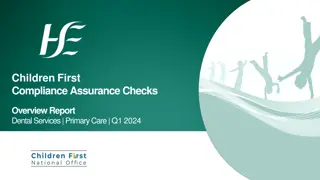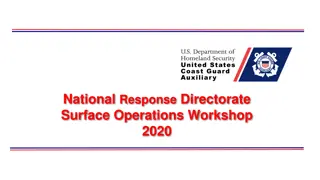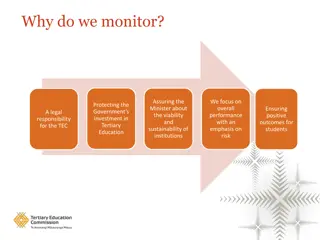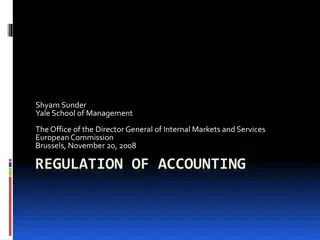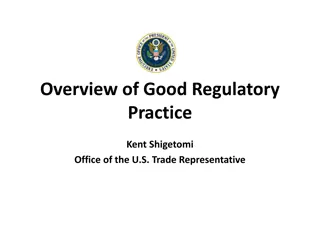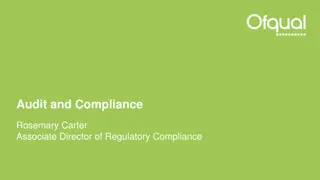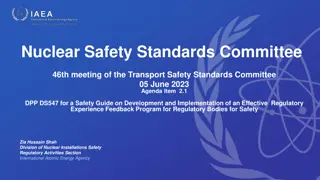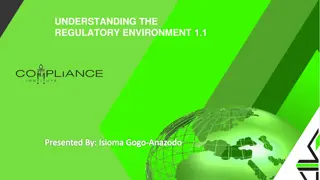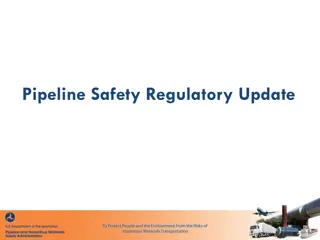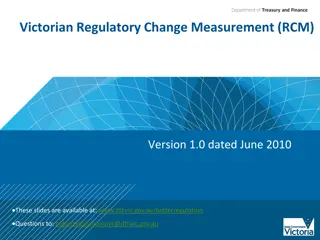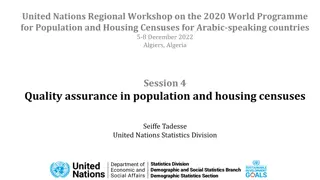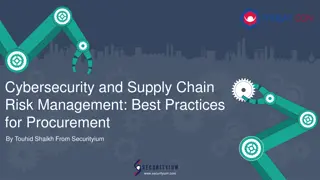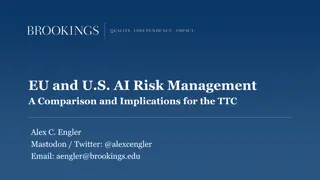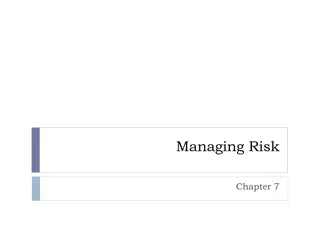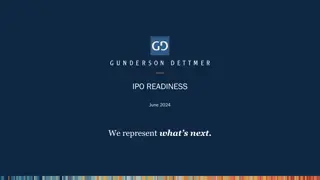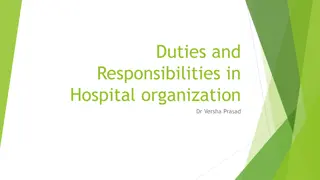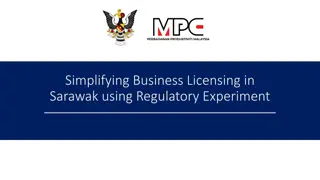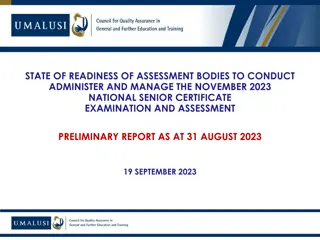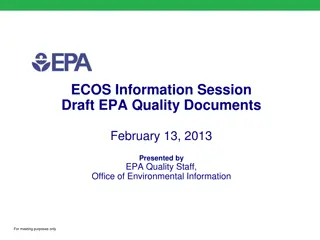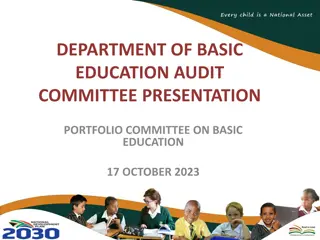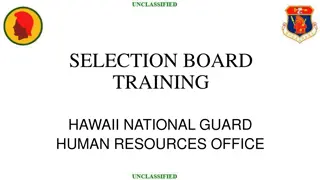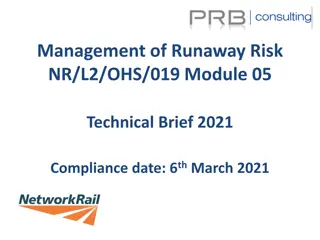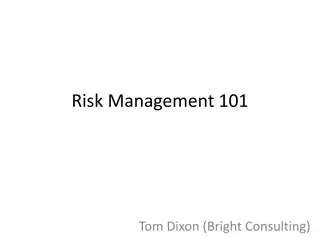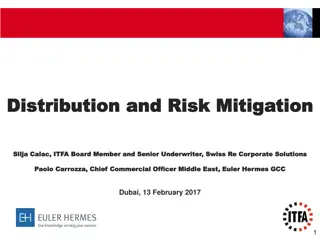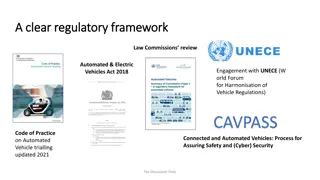Board Responsibilities for Assurance and Risk Management in Regulatory Operations
This document outlines the agenda and key discussions from the sessions on risk management, controls assurance, and value for money in the Regulator of Social Housing meeting in July 2022. It highlights the expectations, focus areas, frameworks, and strategies for managing risks and ensuring effective governance arrangements, internal controls, and business planning. The content emphasizes the importance of delivering strategic objectives, mitigating risks, and providing assurance in regulatory operations.
Download Presentation

Please find below an Image/Link to download the presentation.
The content on the website is provided AS IS for your information and personal use only. It may not be sold, licensed, or shared on other websites without obtaining consent from the author. Download presentation by click this link. If you encounter any issues during the download, it is possible that the publisher has removed the file from their server.
E N D
Presentation Transcript
Board responsibilities for assurance and risk management Karen Doran Assistant Director Regulatory Operations
Agenda Session 1 Risk management, controls assurance and stress testing The role of the Audit Committee Session 2 Value for money (VfM) 2 Regulator of Social Housing July 2022
Risk management expectations and focus Strategic delivery and risk Operating environment Role of the board Governance Value for Money Regulator of Social Housing July 2022 3
Risk management framework Risk appetite Strategy Risk Risk Risk controls identification assessment Controls assurance Risk and strategic delivery assurance 4 Regulator of Social Housing July 2022
Delivery of strategic objectives Strategy = what the board wants to achieve Growing to meet the needs of a wide range of future tenants Objective= Measurable outcome to deliver this Develop XX number of new affordable homes by XXXX Risk = what might stop it Schemes overrun significantly on costs leading to impairment Controls = what mitigates the risk Management information and reporting to development committee Finance Director challenge, Internal audit, specialist review, external audit Assurance = knowing it is all working Regulator of Social Housing July 2022 5
Regulatory expectations Registered providers shall ensure effective governance arrangements that deliver their aims, objectives and intended outcomes for tenants and potential tenants in an effective, transparent and accountable manner Governance arrangements shall ensure registered providers have an effective risk management and internal controls assurance framework Registered providers shall ensure that they have an appropriate, robust and prudent business planning, risk and control framework Regulator of Social Housing July 2022 6
Governance and Financial Viability (G&FV) Code of Practice 21 Registered providers need to ensure their business planning, risk management and control framework is effective. It should cover all areas of the registered provider s business. This should demonstrate the registered provider fully understands and has considered its operating environment, so it can deliver its business plan and organisational objectives. It does not need to be captured in a single document. 29 Boards are the custodians of social housing assets and the financial viability of the registered providers that hold those assets. The responsibility for managing risks, and specifically risks to social housing assets, lies with boards. 35 The regulator expects registered providers, as part of their risk management approach, to stress test their plans against different scenarios across the whole group. 39 As long-term businesses, registered providers need to ensure that short term decisions do not constrain their ability to cope with risk. This does not prevent registered providers from taking on measured risk to deliver their objectives. It means that when taking on risks, boards should fully understand the impact on their business in the round, as well as on their social housing assets. Boards should have appropriate mitigations and controls in place as well as a strategy to protect those assets during the long term. 7 Regulator of Social Housing July 2022
NHF Code of Governance 2020 Key part of one of the four principles underpinning the Code: The board actively manages the risks faced by the organisation and obtains robust assurance that controls are effective, that plans and compliance obligations are being delivered, and that the organisation is financially viable 4.1 Audit: the board has formal and transparent arrangements ensuring that the organisation is financially viable and maintains both a sound system of internal audit and controls and an appropriate relationship with its external auditors The board can have confidence in the information it receives and there are robust internal controls There is a committee primarily responsible for audit, and there are arrangements for effective internal control assurance and audit functions - external audit 4.2 Audit committee: a committee that exercises independent scrutiny and challenge to provide the board with assurance 8 Regulator of Social Housing July 2022
UK Corporate Governance Code Explicit links between corporate governance and effective risk management processes. The board should establish procedures to manage risk, oversee the internal control framework and determine the nature and extent of the principal risks the company is willing to take in order to achieve its long- term strategic objectives. Prescriptive and comprehensive on the role of the Audit Committee 9 Regulator of Social Housing July 2022
Role and duties of board members Legal structure and charitable status General / common law duty of trust Charitable status significant responsibilities and legal duties Stewards and custodians Company law and director duties 10 Regulator of Social Housing July 2022
How do we assess effectiveness of risk management and internal controls assurance Extent to which viability risks can and are managed / mitigated Taking a whole view bringing governance and viability together How key risks are managed in practice the effectiveness of board oversight Not assessing the quality of documents but operation of framework Reactive - risks crystalised, material internal control(s) failed or is not in place, preventative - gap in board s assurance Delivery of strategic objectives 11 Regulator of Social Housing July 2022
Assessing how key risks are managed in practice In all cases consider materiality Controls and oversight performance assurance arrangements outcomes. Examples Stress testing and mitigation strategies Health & safety compliance Development 12 Regulator of Social Housing July 2022
Example of evidence on management of H&S risks taken from Evidencing Assurance slides Knowledge of stock components and condition (G&V) The risk assessment, (coverage of H&S risks) documented controls (G) Board s assurance management reporting, third-party assurance internal audit, specialist advice, CQC inspection outputs (G) Clarity of responsibility in structures (G) Discussion with members re understanding of risks and key controls, and its assurance that the risk is well managed (G) Board capacity to manage H&S risks - oversight of performance from board or committee (G) Adequacy of financial forecasts for stock investment versus need identified in SCS. (V) Stress testing outputs demonstrate capacity to do more (V) All together this adds up to our assurance on the management of that risk then contributes to management of risk in general. Regulator of Social Housing July 2022 13
Regulating risk management Risk is being managed via proper systems and controls and not by chance Documentation - essential to effective risk management Risk map/assessment: Risk identification identify risks accurately Risk assessment inherent risk Controls weight of controls Risk assessment - residual risk Owners Further actions Assurance Regulator of Social Housing July 2022 14
Risk management framework Risk appetite Strategy Risk Risk Risk controls identification assessment Controls assurance Risk and strategic delivery assurance 15 Regulator of Social Housing July 2022
Risk management framework key elements Risk appetite The level of risk that is acceptable to the Board or management . (IIA) RPs should have a clear understanding of their risk tolerances and ensure that they are appropriate to the scale and nature of the activities they are undertaking . (RSH code of practice) Appetite is a driver of golden rules internal tolerances within which an organisation decides to operate. Usually within bank covenant limits. Appetite should be regularly reviewed by Boards. Sometimes a good idea to include within externally facilitated risk workshops. 16 Regulator of Social Housing July 2022
Identifying risks Objective to travel by train from A to B for a meeting at a certain time Risk?? Failure to get from A to B on time for the meeting Being late and missing the meeting This is simply the converse of the objective This is a statement of the impact of the risk, not the risk itself There is no buffet on the train so I get hungry This does not impact on achievement of the objective Missing the train causes me to be late and miss the meeting This is a risk which can be controlled by making sure I allow plenty of time to get to the station Severe weather prevents the train from running and me from getting to the meeting This is a risk which I cannot control, but against which I can make a contingency plan Regulator of Social Housing July 2022 17
Assurance Confidence / sureness that strategy is being delivered and that risks are being managed within appetite. Needed on risks, data, controls, procedures, strategic and operational performance, Have a plan to achieve it map the sources of assurance the board gets against key risks Management reports / KPIs Internal audits and ccompliance reviews Specialist advice (legal, treasury, H&S) Inspection outputs (e.g. CQC, regulatory judgements) Stress testing outputs and recovery planning Rightsizing Assurance Scope, depth, desk-top, inspection, independent, management Basis in data if data is wrong then assurances will be meaningless Regulator of Social Housing July 2022 18
Stress testing and recovery planning RSH context: Stress testing - Analysis of the impact of risks, or combinations of risks, on business plans to determine the extent of the economic shocks and/or internal failure the plan can cope with. Recovery planning Devising deliverable plans which could be enacted to manage those stress scenarios and allow the business to remain financially viable. Regulator of Social Housing July 2022 19
Stress testing and mitigation planning specific expectations Registered providers shall assess, manage and where appropriate address risks to ensure the long term viability of the registered provider, including ensuring that social housing assets are protected. Registered providers shall do so by carrying out detailed and robust stress testing against identified risks and combinations of risks across a range of scenarios and putting appropriate mitigation strategies in place as a result maintaining a thorough, accurate and up to date record of their assets and liabilities and particularly those liabilities that may have recourse to social housing assets Regulator of Social Housing July 2022 20
Stress testing links with business planning and risk management Information to base decisions on how resources are deployed to deliver strategy Informs the materiality of financial risks Aids understanding of cumulative impact of risks Quantifies and checks application of stated risk appetite Identifies / tests key preventative and detective controls Highlights vulnerabilities Allows orgs to set early warning indicators/triggers for action and golden rules Plans in place to ensure org is well ahead with quantified, realistic and actionable mitigations should the worst happen 21 Regulator of Social Housing July 2022
Stress testing links with business planning and risk management Produces information from which to base decisions about how resources are deployed to deliver strategy Informs the materiality of financial risks Highlights vulnerabilities and allows orgs to set early warning indicators/triggers for action and golden rules Plans in place to ensure org is well ahead with quantified, realistic and actionable mitigations should the worst happen 22 Regulator of Social Housing July 2022
Stress testing and mitigation planning Stress testing should be an integral part of business planning and risk management Stress tests are taxing and consider: internal and external factors, separately and in combination cross group impacts and risks comprehensive asset and liability records information impacts against cash, security and covenants Boards are fully involved in stress testing and recovery planning and that reporting is clear and comprehensive Recovery / mitigation plans to address scenarios are well developed Testing is used to inform risk management, business planning, risk appetite and decision making Regulator of Social Housing July 2022 23
Take aways - session 1 Use stress testing to show how risks might impact on the business and therefore inform controls Identify and quantify the risks to achieving those objectives Be clear about your org s purpose and objectives Have a well articulated assessment of strategic risks and associated controls Be able to evidence good levels of assurance on the design and operation of key internal controls Ask yourselves how you know that risk controls are operating as intended Have a fresh look at board reporting and be satisfied that quality, coverage and frequency is assisting in managing risks Link assurance to risks and be sure you re getting enough assurance that risks are being managed Have processes in place to review risk management and assurance arrangements over time 24 Regulator of Social Housing July 2022
Regulator of Social Housing July 2022 25
Role of the Audit (and Risk) Committee Significant role in audit and has taken on more on risk:- Oversees external audit and the certification of the accuracy of the financial statements. Gains assurance that risks, and changes in risk, are being assessed and that appropriate controls to manage risks are in place Receives and assesses assurances on how well controls are operating and that risks are being managed Delivers an overall opinion about risk management and internal controls assurance Assesses and make recommendations to improve the appropriateness of the risk management and assurance processes The Audit Committee should not itself own or manage risks and is, as with internal audit, not a substitute for the proper role of management in managing risk. Key role in enabling board in its responsibilities but not instead of 26 Regulator of Social Housing July 2022
NHF code of governance 2020 Control and assurance (Principle 4) 4.1 Audit: the board has formal and transparent arrangements ensuring that the organisation is financially viable and maintains both a sound system of internal audit and controls and an appropriate relationship with its external auditors The board can have confidence in the information it receives and there are robust internal controls There is a committee primarily responsible for audit, and there are arrangements for effective internal control assurance and audit functions - external audit 4.2 Audit committee: a committee exercises independent scrutiny and challenge to provide the board with assurance Regulator of Social Housing July 2022 27
VFM Required Outcomes Registered providers must: a. b. clearly articulate their strategic objectives have an approach agreed by their board to achieving value for money in meeting these objectives and demonstrate their delivery of value for money to stakeholders through their strategic objectives, articulate their strategy for delivering homes that meet a range of needs ensure that optimal benefit is derived from resources and assets and optimise economy, efficiency and effectiveness in the delivery of their strategic objectives. c. d. 29 Regulator of Social Housing July 2022
VfM Expectations Registered providers must demonstrate a robust approach to how they decide to use their finances to delivery strategic objectives, considering: Risk appetite, modelling of what can be delivered within it costs and benefits of alternative delivery structures VfM across the whole business Investment in non-social housing activity is contributing to strategic delivery and generating returns commensurate to the risk involved Reporting against RSH and RP s own strategic VfM targets including public reporting that enables stakeholders to understand: comparison on VfM and costs with peers what s been delivered and measurable plans to address any areas of underperformance Regulator of Social Housing July 2022 30
RSH VfM Metrics + Provider specific targets Core Metric Description Reinvestment % Scale of investment in development and capital expenditure on current assets New supply delivered (SHL and non SHL) % Units acquired or developed in the year Gearing % Proportion of borrowing in relation to size of asset base Earnings Before Interest, Tax, Depreciation, Amortisation, Major Repairs Included (EBITDA MRI) Interest Cover % Key indicator for liquidity and investment capacity Headline social housing cost / unit Overall SHL costs and main sub-costs per unit Operating Surplus, (deficit) / Turnover Operating margin (SHL and overall Group ) % Return on capital employed ROCE % Surplus / Deficit PLUS disposal of fixed assets PLUS profit / loss JVs compared to total assets Provider specific measures/targets Regulator of Social Housing July 2022 Relevant to organisation specific aims/strategy 31
The strategic context of VfM Boards increasingly face challenges making decisions regarding their use of assets and resources, including: Increasing property compliance standards and requirements building safety, health and safety, energy efficiency, DHS+ Sustaining quality and value of existing stock customer satisfaction Growth acquiring / building new homes new customers Regeneration, community initiatives, staff 32 Regulator of Social Housing July 2022
VfM board assurance some suggestions Be clear on risk appetite and test the business plan to know what can be delivered whilst maintaining viability Sound targets which will demonstrate delivery of strategic objectives Regular reports on delivery of strategic objectives against agreed budgets and outcomes Reports on investments Reports on costs vs peers maybe externally done Explanations of high costs / under performance / reporting on plans for approval Options for alternative delivery models for the whole business or elements of it Annual accounts statement and other public VfM statements Regulator of Social Housing July 2022 33
Take aways session 2 Strategic objectives measurable targets, reporting and performance Make VfM a meaningful part of decision making - especially investment decisions Effective leadership - drive strategic delivery Challenge VfM performance at strategic and operational levels Understand business stream and subsidiary performance Understand costs and how they compare to peers. Where costs are increasing or high - understand why Know that the allocated resources are delivering what was intended Transparency / accountability to board and stakeholders 34 Regulator of Social Housing July 2022


